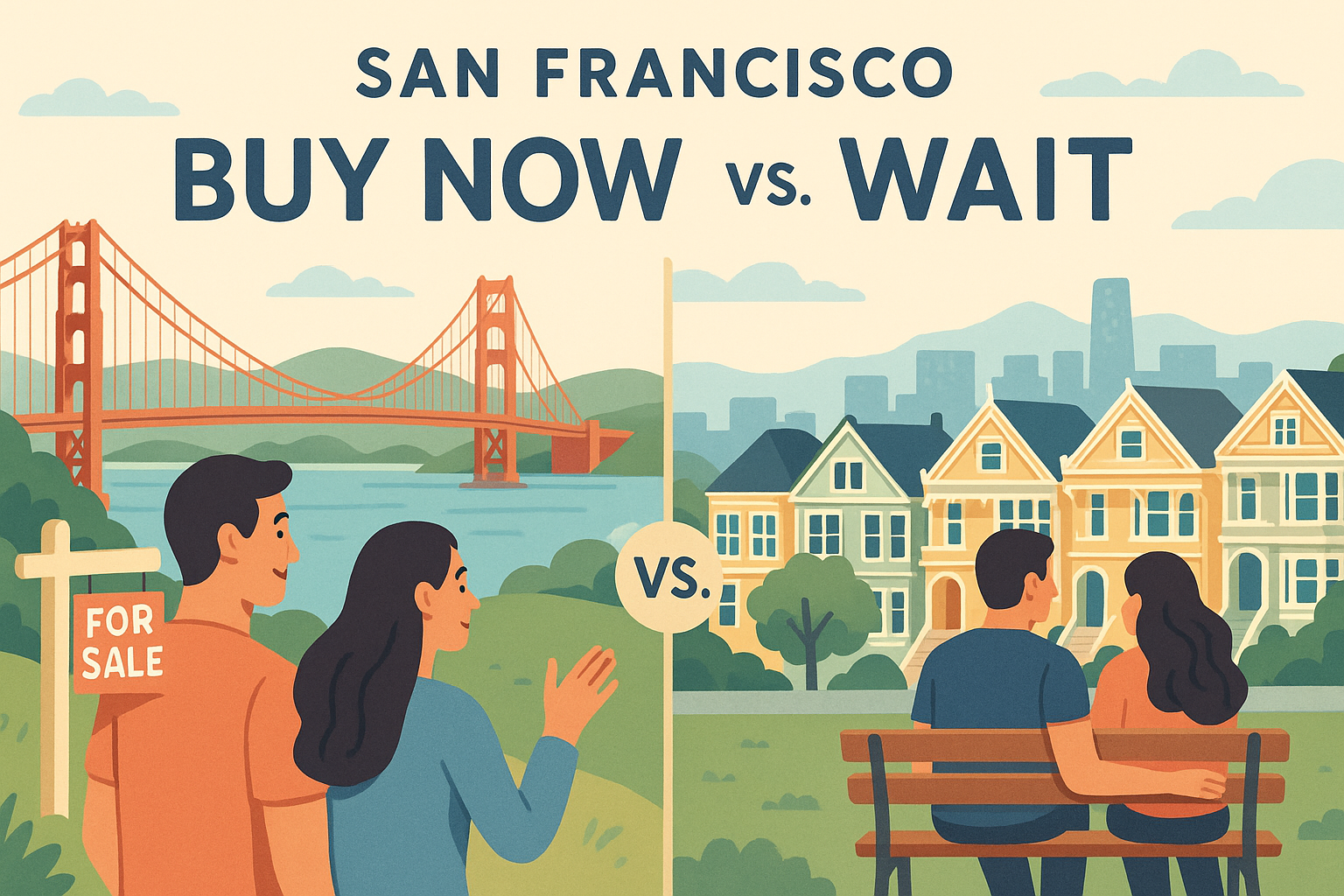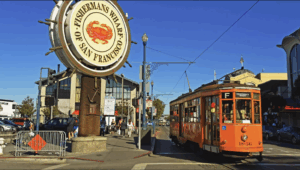A clear, numbers-driven cost/benefit guide for SF buyers
Buying in San Francisco has always involved trade-offs. In 2025, the biggest one is timing: do you buy a home or condo now with ~6.3% mortgage rates, or wait and hope rates fall? Here’s a practical framework—using current market data—to compare both paths and help you pick what’s best for you.
The key facts (as of September 22, 2025)
- Average 30-year fixed mortgage rate: ~6.26% (Freddie Mac PMMS, week of Sept 18).
- San Francisco median sale price (all homes): ~$1.305M in August 2025 (city level).
- SF base property-tax rate FY 2024–25: ~1.171% of assessed value (ex-bonds/fees).
- Baseline rate outlook: Major forecasters (Fannie Mae ESR) see gradual declines toward the ~6.0% area into 2026—not a plunge.
Why this matters: If rates drift lower slowly while Bay Area demand revives, price competition can offset (or erase) the monthly savings from a slightly cheaper mortgage. (NAR and others have warned of a sales “pop” near 6%.)
Two paths, side-by-side
Below are illustrative numbers for a typical SF purchase at today’s median. Adjust down or up for your price point.
Assumptions (same for both paths unless noted):
Purchase price $1.305M; 20% down; loan $1,044,000; conventional 30-yr fixed; condo HOA placeholder $600/mo if applicable; SF property tax 1.171%; homeowners insurance $100/mo (varies). Rates and prices will differ by buyer and property.
Path A — Buy Now
- Rate: ~6.26% (Freddie Mac weekly average).
- Principal & interest (P&I) rough rule: ≈ $6,400/mo (30-yr at ~6.25% runs ≈$6.16 per $1,000 borrowed; $1.044M × 6.16 ≈ $6,430).
- Property tax: ≈ $1,270/mo (1.171% of $1.305M ÷ 12).
- Insurance: ~$100/mo (varies).
- HOA (if condo): placeholder $600/mo.
- Estimated carrying cost (condo example): ~$8,400/mo all-in (P&I + tax + ins + HOA).
Upside of buying now
- You start building equity immediately—both from principal paydown and any appreciation.
- You can refinance later if rates fall without facing a potentially higher purchase price.
- Less exposure to bidding wars if competition heats up as rates tick lower. (Economists expect demand to jump closer to ~6%.)
Downside of buying now
- Higher monthly payment than you’d have at, say, 5.75%–6.00%.
- If the market softens in your segment, short-term paper equity could be volatile.
Path B — Wait 6–12 months for lower rates
- What you’re hoping for: Rates near ~6.0% or a bit below (some forecasts suggest late-2026).
- But what may also happen: More buyers re-enter, and prices/competition pick up—offsetting lower-rate savings. (Historically, every 0.5% drop in rates boosts buying power ~5%—which can translate into higher bids.)
Illustrative “wait” scenarios (same property type, different outcomes):
| Scenario | Rate | Price Drift | New Loan | Rough P&I | Net Effect vs. “Buy Now” |
|---|---|---|---|---|---|
| B1: Rates dip, prices flat | 6.00% | 0% | $1.044M | ≈ $6,240/mo | Save ≈ $190/mo |
| B2: Rates dip, prices +3% | 6.00% | +3% → $1.344M | $1.075M | ≈ $6,420/mo | No P&I savings; tax ↑ |
| B3: Rates 5.75%, prices +5% | 5.75% | +5% → $1.370M | $1.096M | ≈ $6,400/mo | P&I ≈ same as now; tax ↑ |
Takeaway: Unless rates fall more than prices rise, your monthly P&I savings can evaporate—and your property tax bill rises with the new (higher) purchase price.
Upside of waiting
- If rates fall and prices stay tame in your segment, you lock in a lower monthly nut without refinancing.
- A longer runway to save cash, improve credit, or target a more precise property.
Downside of waiting
- You’re exposed to price risk (and tax-growth risk) if demand rebounds.
- Potential for multiple-offer dynamics and reduced contingencies if listings tighten.
- You miss 12 months of principal paydown & potential appreciation.
The real breakeven: how much must rates fall to beat “buy now”?
A helpful rule of thumb: for a given monthly payment target, each 0.50% rate drop generally supports paying ~5% more for the same payment. If SF prices rise anywhere near the extra “buying power” created by falling rates, the payment advantage largely disappears.
- If rates fell from 6.26% → 5.76% (~-0.5%), but your segment’s prices rise ~5%, your P&I is about flat—and your taxes are higher due to the higher assessed value.
- If rates only reach ~6.0% while prices rise 3–5%, many buyers will see minimal monthly savings versus buying today, especially once HOA/insurance/taxes are included.
Context for San Francisco specifically
- Prices have been relatively stable on a citywide median basis in 2025 (+0.6% YoY in August), but segment-level trends vary (condo vs. SFR, neighborhood, condition). Stability means waiting doesn’t guarantee cheaper entry.
- Base property tax is formulaic (~1.171%), so buying later at a higher price mechanically boosts your tax bill even if your rate is a bit lower.
So…which path wins?
Buy now tends to win if:
- You find a good property match today (quality, location, layout) and plan to own 7–10+ years.
- Your budget is comfortable at current payments, and you view refinance as a bonus, not a necessity.
- You want to avoid a possible competition spike if rates slide toward 6%. Barron’s
Wait tends to win if:
- Your budget is tight at today’s payment and a ~0.5–0.75% rate drop would materially shift affordability and your target niche is unlikely to see bidding wars (e.g., ample inventory in a specific condo tier).
- You need time to enhance your down payment, credit, or income stability—which can yield better pricing than a modest rate move alone.
Actionable game plan (San Francisco buyers)
- Price your niche, not just the city median. Some micro-markets (e.g., specific condo buildings or TICs) behave differently than SFRs in Noe, Inner Richmond, etc.
- Run two offers models: “Now” vs. “Wait.” Use your exact down payment, HOA, tax basis, and insurance quotes.
- Hunt refi-friendly loans: If you buy now, prioritize programs with reduced-cost or no-cost streamlined refis.
- Target motivated listings: Price and terms often matter more than chasing a theoretical 25–50 bps rate drop.
- Mind total monthly, not just P&I: HOA dues, taxes, and insurance can dwarf the savings from a small rate move.
Bottom line
In today’s SF market, waiting only “wins” if rates fall more than prices rise in your specific segment—and current forecasts point to gradual, not dramatic, rate relief. If you can comfortably carry the payment today and you find the right home, buying now with a plan to refinance often delivers the best blend of certainty, equity building, and upside. If your budget is tight or your segment has slack inventory, a disciplined wait—with clear triggers (rate, price, or property)—can make sense.



